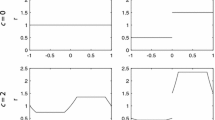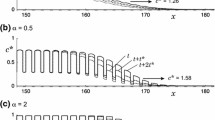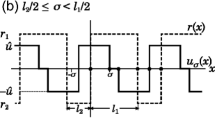Abstract
We analyze traveling front solutions for a class of reaction-transport Lattice Models (LMs) in order to claim their interest on the description of biological invasions. As lattice models are spatially discrete models, we address here the problem of invasions trough patchy habitats, where every node in the lattice represents a different patch. Distributed generation times for the individuals are considered, so that different temporal patterns can be studied. Specifically, we explore some examples of seasonal and nonseasonal patterns which may be of ecological interest. The main advantage of the LMs described here is that a direct correspondence between these discrete models and a mesoscopic description of Continuous-Time Random Walks (CTRW) can be found. This point is of great importance, since many times one needs analytical expressions to support or validate numerical results, or vice versa. Finally, that correspondence allows us to provide a discussion about some general aspects of reaction-dispersal models.
Similar content being viewed by others
References
Andow, D.A., Kareiva, P.M., Levin, S.A., Okubo, A., 1990. Spread of invading organisms. Landsc. Ecol. 4, 177–88.
Andrén, H., 1994. Effects of habitat fragmentation on birds and mammals in landscapes with different proportions of suitable habitat: a review. Oikos 71, 355–66.
Arim, M., et al., 2006. Spread dynamics of invasive species. Proc. Nat. Acad. Sci. USA 103, 374–78.
Baeumer, B., Kovacs, M., Meerschaert, M.M., 2007. Fractional reproduction-dispersal equations and heavy tail dispersal kernels. Bull. Math. Biol. 69, 2281–297.
Brunet, E., Derrida, X., 1997. Shift in the velocity of a front due to a cutoff. Phys. Rev. E 56, 2597–604.
Campos, D., Fort, J., Méndez, V., 2006. Transport on fractal river networks: Application to migration fronts. Theor. Popul. Biol. 69, 88–3.
Campos, D., Méndez, V., 2008. A Lattice-model representation of continuous-time random walks. J. Phys. A 41, 085101.
Chopard, B., Droz, M., 1998. Cellular Automata Modeling of Physical Systems. Cambridge Univ. Press, Cambridge.
Durrett, R., Levin, S., 1994a. Stochastic spatial models: A users guide to ecological applications. Philos. Trans. R. Soc. B 343, 329–50.
Durrett, R., Levin, S., 1994b. The importance of being discrete (and spatial). Theor. Popul. Biol. 46, 363–94.
Fagan, W.F., et al., 2005. When can herbivores slow or reverse the spread of an invading plant? A test case from mount St. Helens. Am. Nat. 166, 669–85.
Fedotov, S., 2001. Front propagation into an unstable state of reaction-transport systems. Phys. Rev. Lett. 86, 926–29.
Fedotov, S., Méndez, V., 2002. Continuous-time random walks and traveling fronts. Phys. Rev. E 66, 030102.
Flather, C.H., Bevers, M., 2002. Patchy reaction-diffusion and population abundance: the relative importance of habitat amount and arrangement. Am. Nat. 159, 40–6.
Fisher, R.A., 1937. The wave of advance of advantageous genes. Ann. Eugenics 7, 353–69.
Fort, J., Méndez, V., 1999. Time-delayed theory of the neolithic transition in Europe. Phys. Rev. Lett 82, 867–70.
Friedlin, M., 1996. Markov Processes and Differential Equations: Asymptotic Problems. Birkhäuser, Basel.
Grigulis, K., Sheppard, A.W., Ash, J.E., Groves, R.H., 2001. The comparative demography of the pasture weed Echium plantagineum between its native and invaded ranges. J. Appl. Ecol. 38, 281–90.
Grosholz, E.D., 1996. Contrasting rates of spread for introduced species in terrestrial and Marine systems. Ecology 77, 1680–686.
Hassell, M.P., Miramontes, O., Rohani, P., May, R.M., 1995. Appropriate formulations for dispersal in spatially structured models: comments on bascompte & sole. J. Anim. Ecol. 64, 662–64.
Haus, I.W., Kehr, R.W., 1987. Diffusion in regular and disordered lattices. Phys. Rep. 150, 263–06.
Jiang, M., Zhang, Q., 2008. A coupled map lattice model of tree dispersion. Discrete Contin. Dyn. B 9, 83–01.
Johnson, D.M., et al., 2006. Allee effects and pulsed invasion by the gypsy moth. Nature 444, 361–63.
Kawasaki, K., Takasu, F., Caswell, H., 2006. How does stochasticity in colonization accelerate the speed of invasion in a cellular automaton model? Ecol. Res 21, 334–45.
Kendall, B.E., Fox, G.A., 1998. Spatial structure, environmental heterogeneity, and population dynamics: analysis of the coupled logistic map. Theor. Popul. Biol. 54, 11–7.
Kinezaki, N., Kawasaki, K., Takasu, F., Shigesada, N., 2003. Modeling biological invasions into periodically fragmented environments. Theor. Popul. Biol. 64, 291–02.
Kolmogorov, A., Petrovskii, I., Piskunov, N., 1937. Étude de l’équation de la diffusion avec croissance de la quantité de matière et son application à un problème biologique. Mosc. Univ. Bull. Math. 1, 1–5.
Kot, M., Lewis, M.A., van den Driessche, P., 1996. Dispersal data and the spread of invading organisms. Ecology 77, 2027–042.
Lloyd, A.L., 1995. The coupled logistic map: a simple model for the effects of spatial heterogeneity on population dynamics. J. Theor. Biol. 173, 217–30.
Malevanets, A., Kapral, R., 1997. Microscopic model for FitzHugh-Nagumo dynamics. Phys. Rev. E 55, 5657–670.
Méndez, V., Campos, D., Fedotov, S., 2004a. Front propagation in reaction-dispersal models with finite jump speed. Phys. Rev. E 70, 036121.
Méndez, V., Campos, D., Fedotov, S., 2004b. Analysis of fronts in reaction-dispersal processes. Phys. Rev. E 70, 066129.
Méndez, V., Fort, J., Campos, D., 2004c. Speed of travelling fronts: Two-dimensional and ballistic dispersal probability distributions. Europhys. Lett 66, 902–08.
Montroll, E.W., Weiss, G.H., 1965. Random walks on lattices, II. J. Math. Phys 6, 167–81.
Murray, J.D., 2003. Mathematical Biology, 3rd edn. Springer, Berlin.
Neubert, M.G., Caswell, H., 2000. Demography and dispersal: calculation and sensitivity analysis of invasion speed for structured populations. Ecology 81, 1613–628.
Ortega-Cejas, V., Fort, J., Méndez, V., 2004. The role of the delay time in the modeling of biological range expansions. Ecology 85, 258–64.
Othmer, H.G., Dunbar, S.R., Alt, W., 1988. Models of dispersal in biological systems. J. Math. Biol. 26, 263–98.
Piggin, C.M., Sheppard, A.W., 1995. Echium plantagineum L. In: Groves, R.H., Shepherd, R.C.H., Richardson, R.G. (Eds.), The Biology of Australian Weeds, vol. 1. Richardson, Melbourne
Pysek, P., Hulme, P.E., 2005. Spatio-temporal dynamics of plant invasions: linking pattern to process. Ecoscience 12, 302–15.
Sokolov, I.M., Schmidt, M.G.W., Sagués, F., 2006. Reaction-subdiffusion equations. Phys. Rev. E 73, 031102.
Solé, R.V., Valls, J., 1993. On structural stability and chaos in biological systems. J. Theor. Biol. 155, 87–02.
Tilman, D., Kareiva, P., 1997. Spatial Ecology. The Role of Space in Population Dynamics and Interspecific Interactions. Princeton Univ. Press, Princeton.
van Saarloos, W., 2003. Front propagation into unstable states. Phys. Rep. 386, 29–22.
White, S.M., White, K.A.J., 2005. Relating coupled map lattices to integro-difference equations: dispersal-driven instabilities in coupled map lattices. J. Theor. Biol. 235, 463–75.
Williamson, M., Pysek, P., Jarosik, V., Prach, K., 2005. On the rates and patterns of spread of alien plants in the Czech Republic, Britain and Ireland. Ecoscience 12, 424–33.
Yadav, A., Horsthemke, W., 2006. Kinetic equations for reaction-subdiffusion systems: derivation and stability analysis. Phys. Rev. E 74, 066118.
Zanette, D.H., 1992. Multistate cellular automaton for reaction-diffusion processes. Phys. Rev. A 46, 7573–579.
Author information
Authors and Affiliations
Corresponding author
Rights and permissions
About this article
Cite this article
Campos, D., Méndez, V. & Ortega-Cejas, V. Lattice Models for Invasions through Patchy Environments. Bull. Math. Biol. 70, 1937–1956 (2008). https://doi.org/10.1007/s11538-008-9333-2
Received:
Accepted:
Published:
Issue Date:
DOI: https://doi.org/10.1007/s11538-008-9333-2




